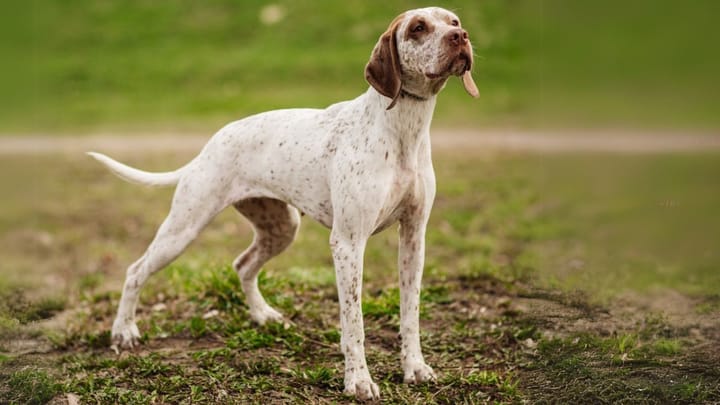Bourbonnais Pointing Dog
Other name: Braque du Bourbonnais

Let’s get one thing out of the way : this French pointing dog’s name is pronounced brack-do-bor-bon-NAY. Originally bred in the historic French region from which the Bourbonnais takes his name (the first part, ‘Braque,’ means ‘pointer’), the brand was recreated from scratch in the 1970s using his finest descendents and a stable of comparable breeds.
He remains popular in France and figures strongly on the North American canine scene, but is not recognized by the UK Kennel Club. A sensible, upstanding dog, the Bourbonnais is well-suited to family life, particularly if the family are the sort of keen outdoors types you read about in books.
|
Life expectancy |
The Bourbonnais Pointing Dog has a life expectancy of between 12 and 14 years |
|
Temperament |
|
|
Size |
Medium
|
|
Adult size |
Female
Between 19 and 22 in
Male
Between 20 and 22 in
|
|
Adult weight |
Female
Between 35 and 49 lb
Male
Between 40 and 55 lb
|
|
Coat colour
White, with fine brown ticking or fawn flecking. Matching brown- or fawn-coloured ears. |
White |
|
Type of coat
The Bourbonnais Pointing dog's hair length is short, fine and dense. |
Short |
|
Eye colour
The Bourbonnais Pointing dog's eyes colours are hazel or amber. |
Brown
|
This breed is not yet recognised by the UK Kennel Club. But he is a terribly good swimmer.
More details about the Bourbonnais Pointing Dog
Bourbonnais Pointing Dog: Origins and history
We know the Braque du Bourbonnais, in his original form, from French paintings and literature stretching back to the 1500s. He is believed to be one of oldest pointing dog varieties to have served human hunters. There were various pointer breeds across France, hailing from the same ancestors; each offshoot breed took the name of the region in which he was developed. And so the Bourbonnais is from Bourbonnais, although neither the region nor the dog exists in its original form today.
The region is now made up of parts of the departments of Allier and Cher. And despite his proficiency at indicating the whereabouts of partridges to his human comrades, the original Braque du Bourbonnais nearly died out. Continued breeding of the original B-de-B dog began to focus on his looks (breeders had a more lilac colour in mind) to the detriment of his skills. Naturally, serious hunters lost interest, and so breeding waned, the creature became increasingly rare, and his good name was removed from the registry of the Societe Centrale Canine (SCC).
In 1925, a group of breeders decided to do something about the plight of the Bourbonnais, and formed the Club du Braque du Bourbonnais – but much of their good work was undone by the advent of World War II. It is also claimed that these breeders continued to emphasize looks over ability. So it is understandable that the Bourbonnais’ post-war fortunes were not good. By 1973, a ten-year gap had passed since the last Bourbonnais pup had been registered.
Up stepped a human, Michel Comte, who was determined to lead the Bourbonnais back to glory. Through dedicated interbreeding of surviving B-de-B’s and similar breeds, he was able to create a new standard, although the FCI wouldn’t stamp its approval until 1991. Meanwhile, several of the creatures had been relocated to the United States, where their continued breeding has received popular, if not official, acclaim. Today, he is both handsome and talented:
"I shot a woodcock, and he ran out pick it up," says of Connecticut hunter Dan Larose. "He picked it up and immediately dropped it. He seemed to say, 'You want these things?' … We didn't lose a woodcock on the whole trip, and we shot quite a few.”
You might not want to hit the killing trail with your Bourbonnais, but be assured he’ll look picturesque as you photograph him snuffling for truffles or casually pointing out the location of an errant golf ball.
Physical characteristics of the Bourbonnais Pointing Dog
This mid-sized dog doesn’t go back as far as you might expect a dog of his height to reach ; but his build is robust and muscular, which strength does not preclude an elegant, even delicate gait. The female is more elegant still. The colour specks on the fur would previously have been referred to as wine dregs or peach blossom ; depending how distributed the coloured fur is among his white coat, and indeed the strength of the beholder’s vision, he may give the impression of being ‘roan’-coloured like a fine, conker-ish horse. At one end, his snout is strong and – due to its broad base – almost cone-shaped. At the other end, if you find a tail at all it is likely to be short. But often, these dogs are born without a tail at all.
FCI classification of the Bourbonnais Pointing Dog
-
Group 7 - Pointing Dogs
-
Section 1 : Continental Pointing Dogs
Bourbonnais Pointing Dog: Characteristics
Bourbonnais Pointing Dog: Behaviour
Training a Bourbonnais Pointing Dog
This dog is whip-smart, eager to learn, and resourceful. Just ensure he gets enough exercise, or he may tend towards the mischievous that so blights the understimulated in our schools and kennels in the UK today.
Bourbonnais Pointing Dog: Lifestyle
Breed compatibility Bourbonnais Pointing Dog
Bourbonnais Pointing Dog: Purchase price
We do not have enough information to set an average price for a Bourbonnais Pointing dog.
The Braque du Bourbonnais can cost around £30 per month to feed and maintain.
Bourbonnais Pointing Dog: Shedding
Average
Shedding is moderate.
Bourbonnais Pointing Dog: Grooming
Regular brushing, bathing, and tooth-brushing are par for the course. More notably, his nails may require more frequent clipping than average, as this breed has a tendency towards fast claw growth.
Bourbonnais Pointing Dog: Health
12-14 years.
This is a sturdy hound, built for life in the fields even if he looks somewhat elegant or fragile. He’s no fighter, but will not grumble at becoming the Passepartout to your Phileas Fogg.
The Bourbonnais is not known to struggle in the heat, although he should be provided with a constant source of fresh water and shade as with any dog.
He won’t grumble at winter weather, but might not tolerate a dive for cold-water ducks since his fur is short and not especially protective against the chill.
Only if he does not get the high levels of exercise he requires.
- Entropion and Ectropion (eyelid deformity/infections)
- Hip Dysplasia
- Pulmonic Stenosis
- Bloating
Do you want a Bourbonnais Pointing Dog dog ?
Oh no...
There are no Bourbonnais Pointing Dog adoption profiles at the moment...





